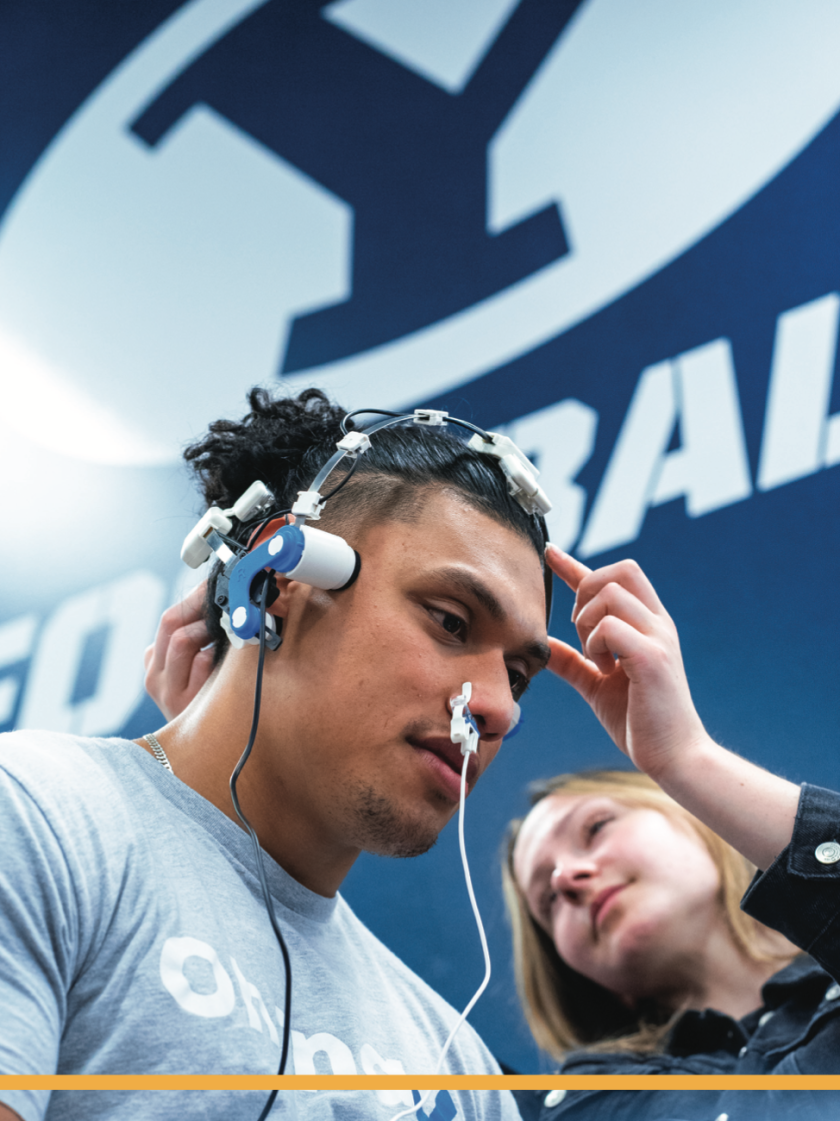In 2002, the death of legendary NFL center Mike Webster introduced the world to the degenerative brain disease known as chronic traumatic encephalopathy (CTE). The disease is marked by depression, rage, substance abuse, cognitive dysfunction, and dementia, and diagnoses are rising rapidly among retired football players.
Research on the effects of CTE is ongoing, but the available data already paints a sobering picture. A 2017 JAMA study found CTE in 99 percent of NFL players examined postmortem, and there are nearly four hundred confirmed cases in the Boston University Brain Bank. But despite the severe threat CTE poses, there is still no clinically accepted treatment that can slow the progression of the disease or offer protection to current athletes. However, a team of students and professors at BYU recently conducted a pioneering study to investigate what may be the first viable treatment for CTE—photobiomodulation.

Photobiomodulation (PBM) is a low-cost, non-invasive therapy that delivers red and near-infrared light exposure to areas of the head and nasal sinuses to stimulate brain tissue. The light passes directly through the intervening bone and tissue and activates neural healing and growth. While the exact mechanisms of healing are uncertain, the therapy appears to work by improving blood flow to damaged areas, counteracting inflammation, and increasing mitochondrial function. Because of this new treatment option, many people with CTE have already experienced life-changing relief from their symptoms.
I had the opportunity to research PBM therapy with students and professors from a range of disciplines, including psychology, biochemistry, exercise sciences, and statistics. We conducted a study over the course of the six months surrounding the 2021 football season, collecting data before and after the season to investigate potential benefits of PBM therapy for players. We analyzed the structure and function of players’ brains, tested their blood for biomarkers of brain injury, and measured their strength, balance, and endurance. The players’ mouthguards were even equipped with accelerometers to measure the force of collisions on the field. We also administered cognitive tests to determine the players’ psychological functionality and sleep quality. In fall of 2022, BYU and Utah State University researchers will continue to collaborate with the BYU football team to study our findings.
As students, we had remarkable opportunities for participation and leadership in the study. Each student developed skills related to their major. Exercise science students tested leg strength using their department’s new Bio-Dex machine, psychology students learned how to read MRIs and evaluate psychological status, and physiology students assessed aspects of the athletes’ balance and agility. As a premed student, I received certification as a phlebotomist, performed blood draws, and learned how to extract plasma for testing.
These hands-on experiences provided an exciting taste of professional life in medicine and academia and helped us gain a clearer picture of our capacities and passions. One of the team leaders, nutritional science student Margaret Hancock (ʼ24), says her favorite part of the research was “working with people, not test tubes or Petri dishes.”

It’s not every day that you can participate in a scientific study while laughing and talking about football with nationally ranked players. “Working with the football players was so fun!” says biology student Natasha Petters (ʼ22). “We always loved chatting with them, and I learned a lot about communicating with people in an experimental setting.”
Even the professors had fun: psychology professor Michael Larson says, “It was exciting to be participating in cutting-edge research, and it was fun to teach students how to properly conduct this type of study.”
Irrespective of our different roles, we all felt lucky to be involved in a study that offered such a variety of opportunities in an engaging environment. And through this research, we have performed one of the first expansive studies of PBM therapy, placing BYU on the frontlines of CTE research. We plan to complete our full analysis and publish the results by the end of 2022.
In my future medical career, I hope to treat and study neurological disorders. This cutting-edge treatment study has opened my eyes to the exhilaration of conducting good research and the hope produced by new medical discoveries. I’ve also become aware of the continued suffering of those for whom effective treatments are not yet available, which has further fueled my desire to seek solutions for current medical issues. I believe I speak for all my fellow researchers when I say that we can’t wait to see how our prospects will grow from here.